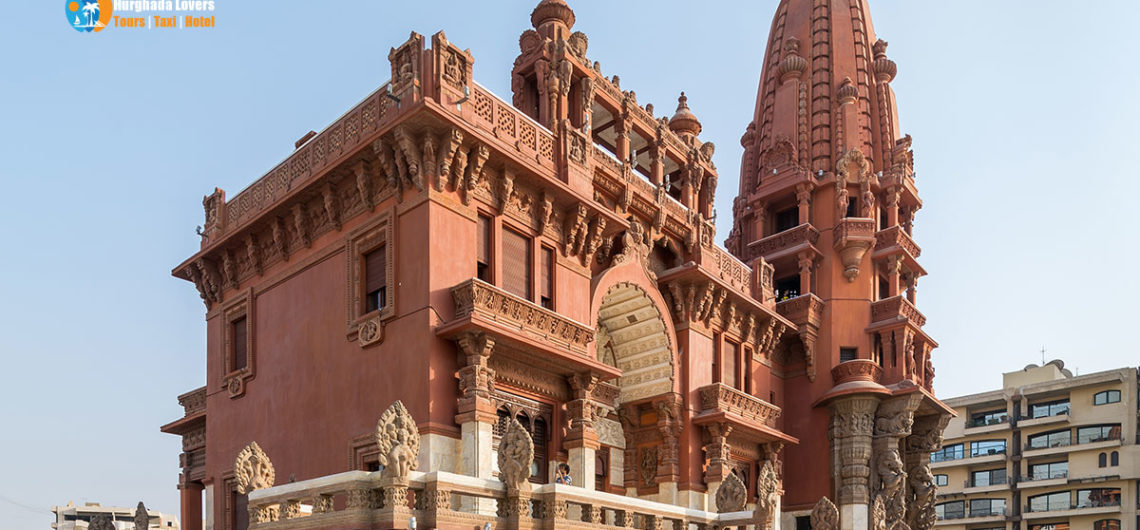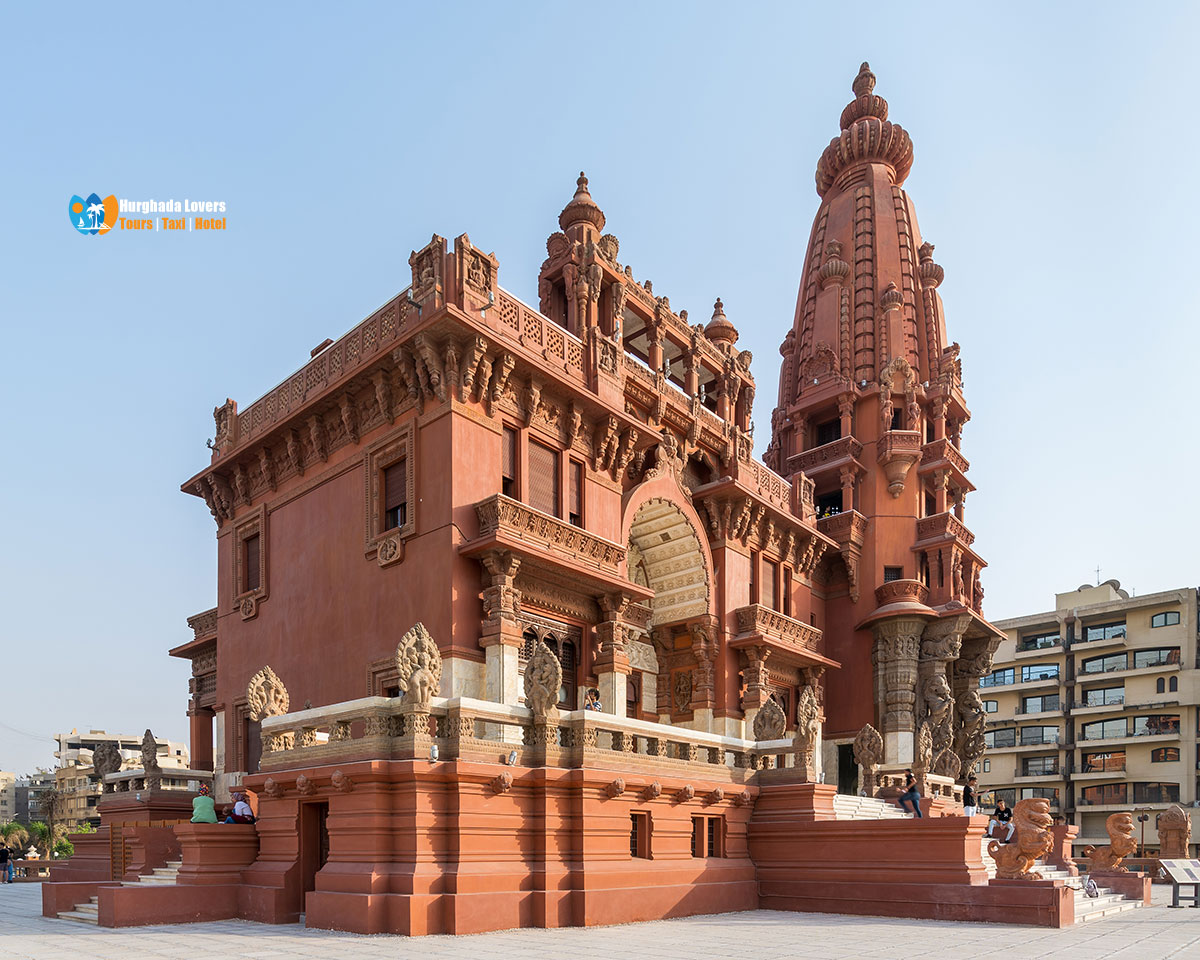The interior plan of the Baron Empain Palace | Best Things to Do in Cairo & The history of the most important and oldest construction in the Heliopolis district of Cairo, Cairo Sightseeing Tour.
History Of Egyptian & Information about the most terrifying and mysterious stories about the palace of Baron Empain in Egypt and the secrets of the palace from inside the pink room and what is the state of the palace now after renovations and restoration to start your cultural journey in Egypt & Things to Do in Egypt.
Hurghada lovers Offer Luxury Hurghada to Luxor Tours | El Gouna to Luxor Tours | Makadi bay to Luxor Tours | Sahl Hasheesh to Luxor Tours | Soma bay to Luxor Tours.
Baron Empain Palace in Cairo Egypt
A complete description of the palace from the inside and outside and what is its history and the stories told about the palace, the truth of these stories, in addition to identifying its place and dates of visits and more.
One of the most interesting and mysterious tourist areas of Cairo is the Baron’s Palace, located on Salah Salem Avenue, in the Heliopolis district, the oldest and most beautiful district of Cairo.
The date of the construction of Baron Empain’s palace:
Built between 1852 and 1929 AD, the palace is located on Oruba Street of Salah Salem Avenue, and it is surrounded by several famous streets such as Ibn Battuta Street and Hassan Sadeq Street in Heliopolis, Cairo Governorate.
The Baron’s Palace is an architectural masterpiece and a legendary palace, not only unique in its design, but in the legends and mysteries that revolve around this prestigious monument.
As for the design of the palace, it is enough to know that the sun is never absent from all its rooms all day long. The palace was built by the Belgian millionaire the Baron Edurard Empain when he came from India to Egypt after the opening of the Suez Canal.
The idea of building the palace began in the Heliopolis Desert east of Cairo, where the Baron Empain then thought well to build a large suburb, he began to build buildings and a metro line connecting the heart of the capital to the district of Heliopolis passing in front of his palace, now known as the Heliopolis metro station, it has the supervision of its architect André Breslo of Belgian nationality in addition to the construction of a large hotel that is now one of the presidential palaces of the Egyptian government.
Architect Alexander Marcel worked on the architectural designs of the Hindu culture strongly represented in the Orissa Temple and in the Temple of Angkor Wat in Cambodia, as well as on the use of the architect Georges Louis Claude to make the interior decorations of the palace.
The palace was completed in 1911 AD.
The owner of the Palace Baron Empain:
The Baron Empain was a famous and wealthy Belgian architect who loved to travel around the world, and when his ship landed on the shores of Egypt, he loved it and he made the decision to stay there until his death, where to build his palace. He began the construction procedures when he proposed to the Egyptian government to create a neighborhood in the desert east of Cairo and chose for it the name “Heliopolis”, that is, the city of the sun, which is the neighborhood of Masr El Gedida today.
After the purchase of the palace land, Baron Empain commissioned the Belgian architect André Perslo to build a metro line in the city, which was still operating about ten years ago, the Heliopolis Metro, as well as to build a series of classic Belgian-style houses with extensive gardens, as well as a huge hotel in Heliopolis.
The interior plan of the Palace:
Your visit to the palace will start with balconies based on statues in the shape of Indian elephants as well as statues of lard and Buddhist style and culture, and you will find a rare clock of which there is only one at Buckingham Palace in England, it shows a show that indicates the time in terms of displaying the days, months, and years, change in daily temperatures and change in the rotation of the moon around the Earth.
The palace consists of 7 bedrooms on two floors, where the first floor consists of 3 guest rooms, a living room, the Hall of Baron Empain and a gym and a billiards salon while the second floor consists of 4 bedrooms and each room has a private bathroom.
You will find the floor of the marble palace, the original alabaster and barcake wood as well as the workers’ rooms and the waiter in the basement.
You will see a collection of gold-plated, platinum, and bronze metal statues and the legendary dragon statue, as well as a tower on the left side of 4 floors with distinctive wooden sides and marble, plaids and decorations on the wall and statues of the lard civilization.
The Baron Empain was interested in importing all kinds of marble from Italy and crystal glass from Belgium, building a full cycle tour every 60 minutes and building a large garden with a collection of rare ornamental plants. You will also find a tunnel connecting the palace to the Basilica Church of Heliopolis.
The 12,500-square-meter-area palace, designed by French architect Alexander Marcel, was decorated by Georges Louis-Claude, a palace inspired by Cambodia’s Angkor Wat Temple and the Hindu Temples of Orissa.
From the inside, it is a small palace consisting of only seven rooms spread over two floors, and its exterior balconies are based on statues of Indian elephants and ivory is spread out inside and outside the palace and is frequented by gold and platinum statues.
The palace is designed in such a way that the sun will not set from its rooms and has a tower that rotates every hour to see who is sitting in everything that surrounds the palace, but the roof of the palace is like a party park because it contains drawings of plants and animals and climbs by a wooden ladder made of fine roses wood.
The Baron Empain was interested in buying Indian and European statues, especially white marble, but many of them have disappeared and perished over time, and you will see statues of dancers, elephants and decorations of Greek and Roman culture.
Since the death of the baron in 1922, the palace was abandoned, until the Egyptian government made the decision to classify it as a historical monument and under the direction of the Egyptian Ministry of Tourism and Antiquities and subsequently begin the process of restoration and care to transform it into a museum or monument of Egyptian heritage.
4 Myths and stories about the goblins and ghosts of the palace:
The first myth: hearing strange sounds of moving furniture in the palace in the middle of the night in addition to suddenly illuminating the backyard of the palace.
Myth II: Thick smoke came out of the palace hall and suddenly disappeared in 1982.
The Baron lived with a birth defect with lameness in his feet, and then he developed epilepsy and convulsions from time to time.
The third legend: the magical pink room forbidden except for the Baron himself which is in the basement of the palace, and it has doors inside that lead to a tunnel that extends to the Basilica.
The fourth legend: the mystery of the murder of the sister of the Baron “Helena”, when she fell from her balcony at the time of the rotation of the tower, where until this moment people believe in the presence of ghosts in her room in the palace, where there are stories that the Baron dragged to not save his sister, which led to the suspension of the tower’s rotation until his death, and his burial in the desert of theHeliopolis desert and many stories and imaginations about recovering his sister’s spirit to apologize to her.
Restoration of the Baron’s Palace after renovation:
The palace is currently fully restored and is currently open to the public.
The cost of the works was up to 110 million Egyptian pounds, and the Egyptian Ministry of Antiquities and Culture directed its opening as a museum of antiquities in addition to organizing concerts on the roof of the palace.
It witnessed several completed works, restoration of the facades, restoration of the decorations on the walls, restoration of the roof of the palace, restoration of al-Kharam columns and metal windows, restoration of statues in addition to preserving the same color as the outer palace with the white color listed with the color of burnt brick.
Dates of visit of the Palace of Baron Empain:
Every day from 9:00 – 15:00.
Entrance ticket prices:
The price of the foreign visitor ticket: 100 Egyptian pounds.
The price of the foreign student ticket: 50 Egyptian pounds
The price of the Egyptian visitor ticket: 20 Egyptian pounds
The price of the Egyptian student ticket: 10 Egyptian pounds.
How many Baron Palace? Egypt
What is the story of the Baron Palace?
To whom is the Baron Palace attributed?
Was the Baron’s Palace spinning?
Why was the Baron Palace called the Ghost House?
How did Baron Empain die?
Author & Writer Baron Empain Palace: Tamer Ahmed Abd elfatah Yousif
Palace of Baron Empain of Cairo Egypt | History of the most important and oldest construction in the Heliopolis district.


